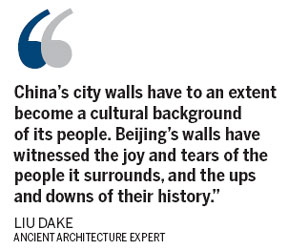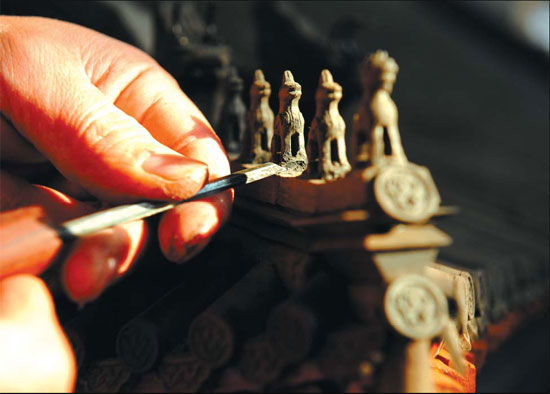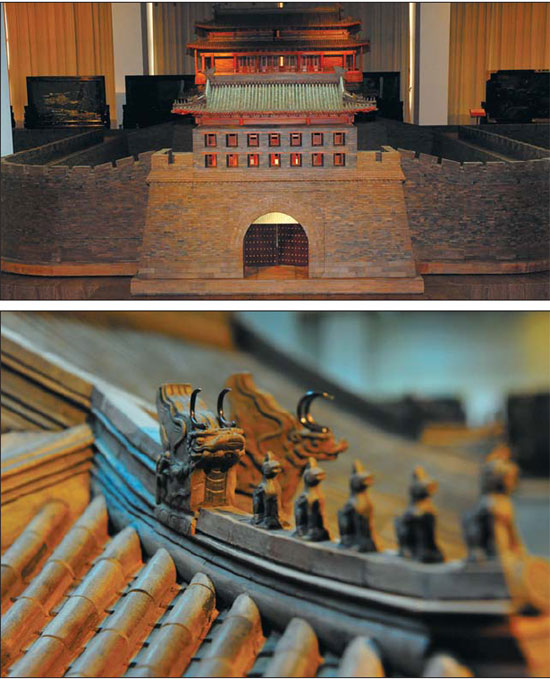Beijing's bulwarks
Updated: 2013-01-15 07:54
By Deng Zhangyu (China Daily)
|
||||||||
|
The red sandlewood and ebony miniature of Yongding Gate displays fine details and craftsmanship. Photos by Lu Zhongqiu / China Daily |
A self-made billionaire is reconstructing the capital's ancient city walls - in miniature and in sandalwood. Deng Zhangyu reports.
Those born before the 1950s remember Beijing's walls as the "city's necklace".
Most of the greatest pearls of this historical treasure have been destroyed but are being reconstructed - in sandalwood, at a tenth of their original size.
Sixteen miniatures will be created, and the first - Yongding Gate, at the south of Beijing's city axis - has been unveiled to the public at Beijing's China Red Sandalwood Museum.
"Younger people don't know what Beijing looked like before," the project's director and museum's founder Chan Laiwa says.
The 71-year-old descendant of a Manchu Yellow Banner clan family spent her childhood in Beijing's hutong (alleys) and grew up playing on the city walls.
She became a self-made billionaire and an art and culture advocate who set out to produce a replica of Beijing's city gates out of red sandalwood and ebony.
Both are costly materials. Red sandalwood trees require centuries to mature while ebony comes from semi-fossilized wood that has lain at the bottom of the great rivers for thousands of years.
"It's hard to find red sandalwood," replica producer, Fuwah Furniture Ltd manager Chen Peilin says.
Chen says ebony is so similar in color to the gates' grey bricks that no paint is required.
The production team employs about 120 designers, ancient architecture experts and craftspeople.
They started work in 2011, and it took them more than a year to produce the maiden model of Yongding Gate, Chen says.
"There are few documents and photos of Beijing's city walls," Chen says.

Beijing is the capital of five dynasties - Liao (916-1125), Jin (1115-1234), Yuan (1271-1368), Ming (1368-1644) and Qing (1644-1911). It consequently developed a comprehensive fortification system built as early as the 15th century. The city consists of the Forbidden City, the imperial city, the inner city and the outer city.
The inner city has nine gates, including Chaoyang and Chongwen, which are now on the second ring road or the Subway Line 2. The Outer City has seven gates, including Yongding.
In the 1950s, there were debates about whether Beijing's city walls should be demolished to give way to modernization.
However, the "father of modern Chinese architecture" Liang Sicheng said the city wall is "the necklace" of Beijing - and even of China.
"China's city walls have to an extent become a cultural background of its people," ancient architecture expert Liu Dake says.
"Beijing's walls have witnessed the joy and tears of the people it surrounds, and the ups and downs of their history."
It's impossible for Beijing to reconstruct its city walls considering its current layout and transportation system, says the 80-year-old Wang Zhongjie, who has worked as an ancient architecture craftsman for 50 years and as a senior Palace Museum engineer.
"Only by producing a scale model of all the 16 city gates can we see the original appearance of ancient Beijing," he says.
At the project's financial helm is Chan, who was voted among Time magazine's 100 Most Influential People of 2012.
Chan says they plan to finish all 16 city walls in six years. Her museum's free space is too small, so she's considering opening a new museum dedicated to the city wall miniatures.
"We're producing a sandalwood and ebony necklace for Beijing, " Liu says.
Contact the writer at dengzhangyu@chinadaily.com.cn.
|
Top and above: For more than a year, 120 designers, ancient architecture experts and craftsmen worked on the first model of Yongding Gate, with more to follow. |
(China Daily 01/15/2013 page18)

 In Photos: 7.0-magnitude quake hits Sichuan
In Photos: 7.0-magnitude quake hits Sichuan
 Li Na on Time cover, makes influential 100 list
Li Na on Time cover, makes influential 100 list
 FBI releases photos of 2 Boston bombings suspects
FBI releases photos of 2 Boston bombings suspects
 World's wackiest hairstyles
World's wackiest hairstyles
 Sandstorms strike Northwest China
Sandstorms strike Northwest China
 Never-seen photos of Madonna on display
Never-seen photos of Madonna on display
 H7N9 outbreak linked to waterfowl migration
H7N9 outbreak linked to waterfowl migration
 Dozens feared dead in Texas plant blast
Dozens feared dead in Texas plant blast
Most Viewed
Editor's Picks

|

|

|

|

|

|
Today's Top News
Live report: 7.0-magnitude quake hits Sichuan, heavy casualties feared
Boston suspect cornered on boat
Cross-talk artist helps to spread the word
'Green' awareness levels drop in Beijing
Palace Museum spruces up
First couple on Time's list of most influential
H7N9 flu transmission studied
Trading channels 'need to broaden'
US Weekly

|

|









